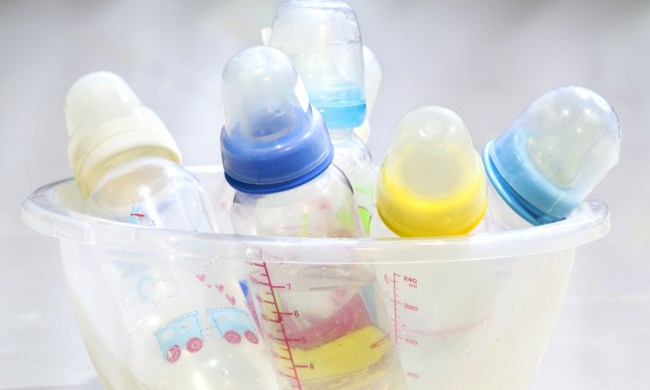
One of the most exciting milestones for parents is when their baby starts eating solid foods. It’s so much fun watching a whole new world of textures and flavors being introduced to your little one. Watching their face as they register if they like a food they are trying for the first time is one of the best things you’ll ever see. When your baby is ready for vegetables, we suggest giving green beans a try. You might be wondering how to make green bean baby food or a green bean puree for your little one. Regardless of your green bean skill level, there’s information here to get you started.
This green superfood is loaded with iron, calcium, and potassium, and it’s a pretty safe bet, as an allergy to green beans is super rare. To be ready to add green beans to the lineup, check out an easy way to make green beans baby food that won’t take longer than 10 minutes.
Basic green bean rule

Before you get started, there a few things to do and be aware of:
- Make sure they are washed
- Cut off the ends when you are going to make the food – not before
- You don’t need a baby food maker — a blender or food processor is fine
- You can use frozen or fresh green beans
- Frozen will come out smoother in a puree
- With fresh, you might have to strain for a puree
- If you don’t have a steamer — the microwave works just fine
Check off all of these before starting any recipes.
Age guidelines

6 months
At 6 months, your baby is just learning how to eat solid foods. You should introduce one new food every week just in case they have allergies. For a 6-month-old, if you aren’t giving them a puree form of green beans, then you’ll need to make sure the green beans are full length and overly cooked to minimize choking.
8 to 9 months
Around 8 to 9 months old, or when your baby starts to get a few teeth in, you can experiment with the consistency of the puree, allowing it to be thicker and chunkier.
9 to 12 months
By 12 months, your baby should have some teeth. You can cut the green beans up into smaller pieces. You can also cook them a minute or so less to give them a bit of a bite. When making puree you can have it more of a mash.
12 to 18 months
After 12 months, you can give them smaller cut pieces and only cook them for a few minutes to barely soften them up.
Now, let’s check out the recipes.
Super soft green beans

What you’ll need
- Green beans — a handful
- Steamer
To get your baby accustomed to the taste of green beans you can give them extremely cooked, whole green beans. Steam them for the whole 10 minutes so they are nice and soft. As long as you are there to keep an eye on them, you can give them full pieces to grab and gum on.
Green bean puree

What you’ll need
- Fresh green beans — 1 cup
- Water/breast milk/formula — a few tablespoons
- Steamer
- Blender
When introducing your baby to vegetables, the puree is the way to go and is easy. You’ll only need to steam the green beans for about 5 minutes, then strain them and put them in the blender. You’ll want to add a little bit of water or formula to start. A tablespoon or two is OK. Blend the green beans up and check the consistency. If it’s too thick for your liking, add a little bit more water.
Once it’s as smooth as you want, let your little one give it a try. Whatever your baby doesn’t eat, you can put it into a sealable glass jar for later or freeze it in an ice cube tray for another day.
Green bean and squash puree

What you’ll need
- Green beans — 1 cup
- 1 squash
- Water/breast milk/formula
- Steamer
- Blender
This is the same as the green bean puree — but with squash added. If you tried the straight green bean version and your child is giving it a thumbs down, mixing it with another food can hide the taste a bit. You can also do this with sweet potatoes or carrots. Rotate them to see which your baby likes best.
Green beans with olive oil and basil puree

What you’ll need
- Green beans — 1 cup
- Olive oil — 1 teaspoon
- Basil — a leaf or two
- Steamer
- Blender
Steam the green beans and toss them in the blender or food processor. Add in the olive oil and basil before you blend.
Green bean and zucchini

What you’ll need
- Green beans — 1 cup
- Zucchini — 1 of medium size
- Chives (optional)
Cook the green beans and zucchini in a pan for about 5 minutes. Once soft, you can mash them up slightly so it’s easier for your child to chew. Top with a sprinkle of finely chopped chives. This wouldn’t make a bad side dish for the whole family.
Green beans, blueberries, and bananas

What you’ll need
- Green beans — 1/2 cup
- Blueberries — 2/3 cup
- Banana — 1 chopped
- Lemon juice — 1/2 teaspoon
- Steamer for green beans
- Blender
Once the green beans are steamed, toss them in the food processor with the banana, blueberries, and lemon juice and blend until you get the smoothness you want. The sweetness of the fruit will hide the green beans nicely but still go together well so your child won’t pull a face.
Why green beans make great baby food

Loaded with vitamins K, C, and A and plenty of minerals, green beans are a smart choice for the first vegetable to introduce to your baby. They also contain folate, which helps your baby’s cells divide. Not to mention the fact that beans are a great source of fiber, which can help keep your little one regular and alleviate constipation.
Studies also show that babies who eat a fiber-rich diet tend to consume more nutrients like vitamin B, potassium, and magnesium as well as a lower fat intake compared to those who don’t eat a fiber-rich diet. Not only are green beans a healthy first vegetable to feed your little one, but they’re tasty and easy to eat, too.
Making baby food is easy and simple and it doesn’t have to be overwhelming. It’s not an all-day process, either. Once your baby has mastered grains and moves on to vegetables, try any of these delicious green bean recipes. So many baby food recipes only take 10 minutes or less. You’ll save money and give your baby the freshest and safest ingredients when you make it yourself.



